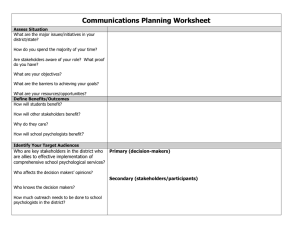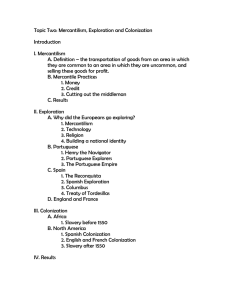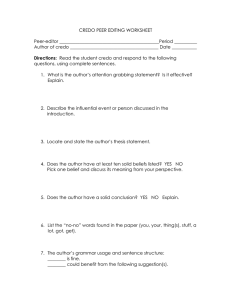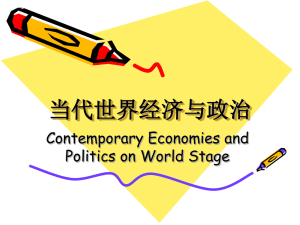Daiva Ahire LIB 200 Prof. Tom Regan 10/21/2009
advertisement
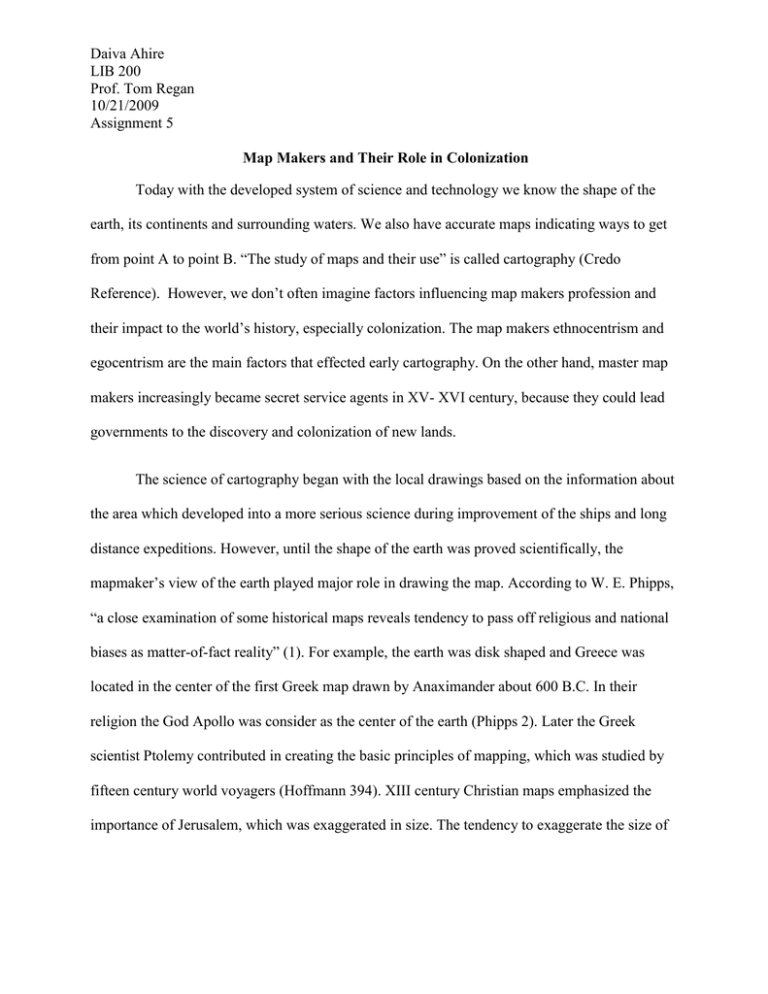
Daiva Ahire LIB 200 Prof. Tom Regan 10/21/2009 Assignment 5 Map Makers and Their Role in Colonization Today with the developed system of science and technology we know the shape of the earth, its continents and surrounding waters. We also have accurate maps indicating ways to get from point A to point B. “The study of maps and their use” is called cartography (Credo Reference). However, we don’t often imagine factors influencing map makers profession and their impact to the world’s history, especially colonization. The map makers ethnocentrism and egocentrism are the main factors that effected early cartography. On the other hand, master map makers increasingly became secret service agents in XV- XVI century, because they could lead governments to the discovery and colonization of new lands. The science of cartography began with the local drawings based on the information about the area which developed into a more serious science during improvement of the ships and long distance expeditions. However, until the shape of the earth was proved scientifically, the mapmaker’s view of the earth played major role in drawing the map. According to W. E. Phipps, “a close examination of some historical maps reveals tendency to pass off religious and national biases as matter-of-fact reality” (1). For example, the earth was disk shaped and Greece was located in the center of the first Greek map drawn by Anaximander about 600 B.C. In their religion the God Apollo was consider as the center of the earth (Phipps 2). Later the Greek scientist Ptolemy contributed in creating the basic principles of mapping, which was studied by fifteen century world voyagers (Hoffmann 394). XIII century Christian maps emphasized the importance of Jerusalem, which was exaggerated in size. The tendency to exaggerate the size of Daiva Ahire LIB 200 Prof. Tom Regan 10/21/2009 Assignment 5 the country by the natives remained for a long time. Each country wanted to portray itself as a vast terrain compared to others to intimidate and to feign superiority with a narcissistic tendency. As more voyages took place, maps were used for navigation purpose to discover and colonize new lands. Colonization is defined as “extension of political and economic control over an area by a state whose nationals have occupied the area and usually possess organizational or technological superiority over the native population” (Credo Reference). Maps drawn by Gerard Mercator were used for navigation purposes, however due to inaccurate drawings the countries in Northern hemisphere felt superior over the continents in the South hemisphere. Mercator’s world view was used to rationalize colonial exploitation (Phipps 3). As more discoveries of unknown territories took place, the job of map makers became increasingly secret. Dominant countries in XV-XVI century explorations like Portuguese, Spain and Great Britain became competitors and wanted to protect their information. The evidence of keeping the cartographic secrets could be found in the discovery of Australia. The discovery of Australia was assigned to the British explorer Captain Cook. However, some cartographic evidences like maps, charts and atlases, dated 1540-70, shows the land in place of Australia named as Java-La-Grande (Wallis 30). These maps were drawn by the Dieppe school of chart makers in France, which evidently had cartographers from Portugal. According to Helen Wallis, “it has been suggested that Portuguese government’s ‘policy of secrecy’ may have required suspension of the discovery” (31). Even though Portuguese are lacking direct evidence of discovering Australia, historical facts support hypothesis of competition among the countries Daiva Ahire LIB 200 Prof. Tom Regan 10/21/2009 Assignment 5 for the hunger to discover and colonize more land. Map makers on the other hand had to keep the secrets of navigation. In conclusion, early cartography was affected by the world view of their creators. The center of the world tends to be the creators home country. Culture and especially religious believes also shaped early mapmakers perspective of the world. With the development of the map drawing techniques more maps were used for navigation purpose. Long distance voyages had inspired explorers to colonize unknown lands. The role of map makers grew increasingly important and secretive since their mapping system could lead to new discoveries. Their knowledge became valuable and hence was protected by the government. Daiva Ahire LIB 200 Prof. Tom Regan 10/21/2009 Assignment 5 Works Cited “cartography." The Dictionary of Human Geography. Oxford: Blackwell Publishers, 2000. Credo Reference. Web. 21 October 2009. "colonization." The Columbia Encyclopedia. New York: Columbia University Press, 2008. Credo Reference. Web. 21 October 2009. Hoffmann, James J. “The Early History of Cartography.” Science and its Times. Ed. Neil Schlager and Josh Lauer. Vol. 1: 2,000 B.C. to A.D. 699. Detroit: Gale, 2001. p393395.Gale Virtual Reference Science Collection. Gale. CUNY - LaGuardia Community College. 19 October 2009 Phipps, W.E. “Cultural Commitments and World Maps.” Focus. Vol. 41. Issue 2. 1991. Academic Search Complete.19 October 2009. Wallis, Helen. “Did The Portuguese Discover Australia?” History Today. Vol. 38. Issue 3. p. 3035. 1988. Academic Search Complete. 20 October 2009.

